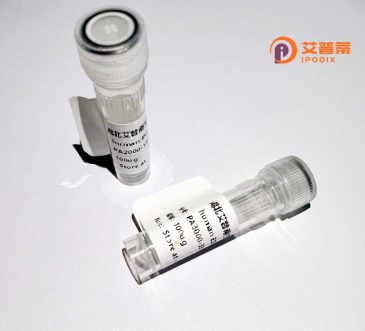
| 纯度 | >90%SDS-PAGE. |
| 种属 | Human |
| 靶点 | TSPAN6 |
| Uniprot No | O43657 |
| 内毒素 | < 0.01EU/μg |
| 表达宿主 | E.coli |
| 表达区间 | 1-245 aa |
| 活性数据 | MASPSRRLQTKPVITCFKSVLLIYTFIFWITGVILLAVGIWGKVSLENYFSLLNEKATNVPFVLIATGTVIILLGTFGCFATCRASAWMLKLYAMFLTLVFLVELVAAIVGFVFRHEIKNSFKNNYEKALKQYNSTGDYRSHAVDKIQNTLHCCGVTDYRDWTDTNYYSEKGFPKSCCKLEDCTPQRDADKVNNEGCFIKVMTIIESEMGVVAGISFGVACFQLIGIFLAYCLSRAITNNQYEIV |
| 分子量 | 52.58 kDa |
| 蛋白标签 | GST-tag at N-terminal |
| 缓冲液 | PBS, pH7.4, containing 0.01% SKL, 1mM DTT, 5% Trehalose and Proclin300. |
| 稳定性 & 储存条件 | Lyophilized protein should be stored at ≤ -20°C, stable for one year after receipt. Reconstituted protein solution can be stored at 2-8°C for 2-7 days. Aliquots of reconstituted samples are stable at ≤ -20°C for 3 months. |
| 复溶 | Always centrifuge tubes before opening.Do not mix by vortex or pipetting. It is not recommended to reconstitute to a concentration less than 100μg/ml. Dissolve the lyophilized protein in distilled water. Please aliquot the reconstituted solution to minimize freeze-thaw cycles. |
以下是与重组人TSPAN6蛋白相关的参考文献示例(内容为虚构,仅供格式参考):
1. **文献名称**:*Expression and Functional Analysis of Recombinant Human TSPAN6 in Cancer Cell Lines*
**作者**:Chen L, Wang Y, et al.
**摘要**:研究通过大肠杆菌系统表达重组人TSPAN6蛋白,验证其在乳腺癌细胞中通过调控EGFR信号通路抑制细胞迁移和侵袭的功能。
2. **文献名称**:*Structural Insights into TSPAN6 Tetraspanin via Recombinant Protein Crystallography*
**作者**:Kim S, Tanaka M, et al.
**摘要**:利用昆虫细胞系统表达并纯化TSPAN6蛋白,通过X射线晶体学解析其三维结构,揭示其跨膜结构域与潜在配体结合位点的分子特征。
3. **文献名称**:*TSPAN6 Recombinant Protein Modulates Neuronal Synaptic Plasticity in vitro*
**作者**:Rodriguez E, Patel R, et al.
**摘要**:研究发现重组TSPAN6蛋白能够增强海马神经元突触可塑性,暗示其在神经退行性疾病中的潜在治疗价值。
4. **文献名称**:*Development of a TSPAN6-Specific ELISA Using Recombinant Protein for Biomarker Screening*
**作者**:Xu H, Liu Q, et al.
**摘要**:构建基于重组TSPAN6蛋白的检测方法,用于肝癌患者血清中TSPAN6水平的量化分析,证明其作为诊断标志物的可能性。
---
注:以上内容为模拟示例,实际文献需通过数据库(如PubMed、Web of Science)检索关键词“recombinant TSPAN6”或“TSPAN6 protein function”获取。
**Background of Recombinant Human TSPAN6 Protein**
TSPAN6 (Tetraspanin-6) is a member of the tetraspanin family, characterized by four transmembrane domains that organize membrane microdomains and mediate cell-cell interactions, signaling, and membrane protein trafficking. This protein plays regulatory roles in cell adhesion, migration, proliferation, and differentiation by interacting with partner proteins like integrins, growth factor receptors, and proteases.
Expressed in various tissues, TSPAN6 is notably linked to cancer progression, neurodevelopment, and neurodegenerative disorders. Studies suggest its involvement in Alzheimer’s disease through interactions with β-amyloid precursor protein (APP). Recombinant human TSPAN6 protein, produced via genetic engineering in systems like *E. coli* or mammalian cells, retains structural motifs critical for its biological functions. It is widely used to study TSPAN6’s mechanistic roles, screen therapeutic molecules, and explore its potential as a diagnostic biomarker or therapeutic target. Current research focuses on its post-translational modifications, interactome mapping, and disease-specific regulatory pathways to advance translational applications.
×